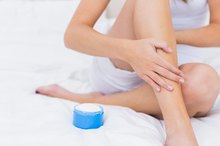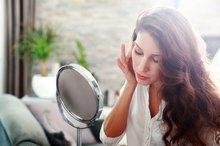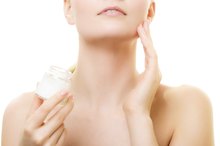What does fact checked mean?
At Healthfully, we strive to deliver objective content that is accurate and up-to-date. Our team periodically reviews articles in order to ensure content quality. The sources cited below consist of evidence from peer-reviewed journals, prominent medical organizations, academic associations, and government data.
- U.S. Food and Drug Administration: Topical Acne Products Can Cause Dangerous Side Effects
- The Journal of Investigative Dermatology: Propionibacterium Acnes Induces an Interleukin-17 Response in Acne Vulgaris that is Regulated by Vitamin A and Vitamin D
- The Journal of Investigative Dermatology: Propionibacterium Acnes Induces an Interleukin-17 Response in Acne Vulgaris that is Regulated by Vitamin A and Vitamin D
- The Journal of Clinical and Aesthetic Dermatology: Over-the-counter Acne Treatments
- The Journal of Clinical and Aesthetic Dermatology: Over-the-counter Acne Treatments
- MedlinePlus: Salicylic Acid
The information contained on this site is for informational purposes only, and should not be used as a substitute for the advice of a professional health care provider. Please check with the appropriate physician regarding health questions and concerns. Although we strive to deliver accurate and up-to-date information, no guarantee to that effect is made.
Alternatives to Benzoyl Peroxide
Benzoyl peroxide is an over-the-counter acne treatment that can be used to kill the bacteria occurring in the skin's pores. However, benzoyl peroxide can cause irritation and dryness, which may lead others to seek acne treatment alternatives. A variety of treatments are available to reduce the appearance of acne and promote smoother skin, including salicylic acid, tea tree oil and Vitamin A creams 4.
Salicylic Acid
Salicylic acid is an over-the-counter treatment used to treat and prevent acne 34. While benzoyl peroxide acts as an anti-inflammatory and antibacterial agent, salicylic acid is a keratolytic agent, meaning it sloughs away dead skin cells and oils to remove the "plugs" that cause acne 4. Because it takes time to rid the pores of these plugs, salicylic acid may take several weeks before a significant improvement is noticed 4. Salicylic acid is available in a variety of forms, including gel, cream, wash or medicated pad 4. Salicylic acid is associated with some mild side effects, including redness and irritation 4. However, these should subside with continued use.
Tea Tree Oil
Vitamin E Oil for Rosacea
Learn More
A natural antiseptic, tea tree oil shares similar properties to benzoyl peroxide. Applying a 5 percent tea tree oil solution to the face has been shown to be as effective as applying a 5 percent benzoyl peroxide solution. However, tea tree oil may not be as fact-acting as benzoyl peroxide. Also, there are a few persons who should not utilize tea tree oil in the treatment of their acne. This includes young boys--tea tree oil has been linked with breast development--and those with rosacea--tea tree oil may exacerbate this skin condition. Lastly, in some persons tea tree oil can result in contact dermatitis, which is an itchy, irritated rash on the face. Discontinue use if you experience this type of rash following application.
- A natural antiseptic, tea tree oil shares similar properties to benzoyl peroxide.
- Also, there are a few persons who should not utilize tea tree oil in the treatment of their acne.
Vitamin A Creams
Prior to the ability to harness vitamin A's acne-fighting powers into a cream, dermatologists prescribed vitamin A to patients in the treatment of acne. When applied to the face, vitamin A creams have a keratolytic effect, meaning they remove the dirt and oil that can clog a pore. For the most part, vitamin A creams are available for prescription only. However, some forms can be purchased over-the-counter and are labeled as containing retinol, a less concentrated form of vitamin A.
The side effects associated with vitamin A creams depend upon the strength and mode of application. However, it is normal to experience some redness, burning and irritation upon initially applying the product to the face. In time, this should subside and clearer skin should be revealed.
- Prior to the ability to harness vitamin A's acne-fighting powers into a cream, dermatologists prescribed vitamin A to patients in the treatment of acne.
- When applied to the face, vitamin A creams have a keratolytic effect, meaning they remove the dirt and oil that can clog a pore.
Related Articles
References
- U.S. Food and Drug Administration: Topical Acne Products Can Cause Dangerous Side Effects
- The Journal of Investigative Dermatology: Propionibacterium Acnes Induces an Interleukin-17 Response in Acne Vulgaris that is Regulated by Vitamin A and Vitamin D
- The Journal of Clinical and Aesthetic Dermatology: Over-the-counter Acne Treatments
- MedlinePlus: Salicylic Acid
- "Acne Treatment Available without a Prescription." AcneNet. American Academy of Dermatology, 2010. Web. 16 Jul 2010.
- Hegemann I, Toso SM, Kitay K, Webster GF. "Anti-inflammatory actions of benzoyl peroxide: effects on the generation of reactive oxygen species by leucocytes and the activity of protein kinase C and calmodulin." Br J Dermatol 1994; 130:569-75.
- Kligman AM. Acne vulgaris: tricks and treatments. Part II: the benzoyl peroxide saga. Cutis 1995;56: 260-1.
- Russel J. "Topical Therapy for Acne." Am Family Physician 2000;61:357-66.
- Zaenglein AL, Thiboutot DM. "Expert Committee Recommendations for Acne Management." Pediatrics 2006; 118(3):1188-99.
- Goodheart, MD, Herbert. Acne for Dummies. Hoboken, NJ: Wiley Publishing, Inc., 2006. 79-81. Print.
Writer Bio
Rachel Nall began writing in 2003. She is a former managing editor for custom health publications, including physician journals. She has written for The Associated Press and "Jezebel," "Charleston," "Chatter" and "Reach" magazines. Nall is currently pursuing her Bachelor of Science in Nursing at the University of Tennessee.









